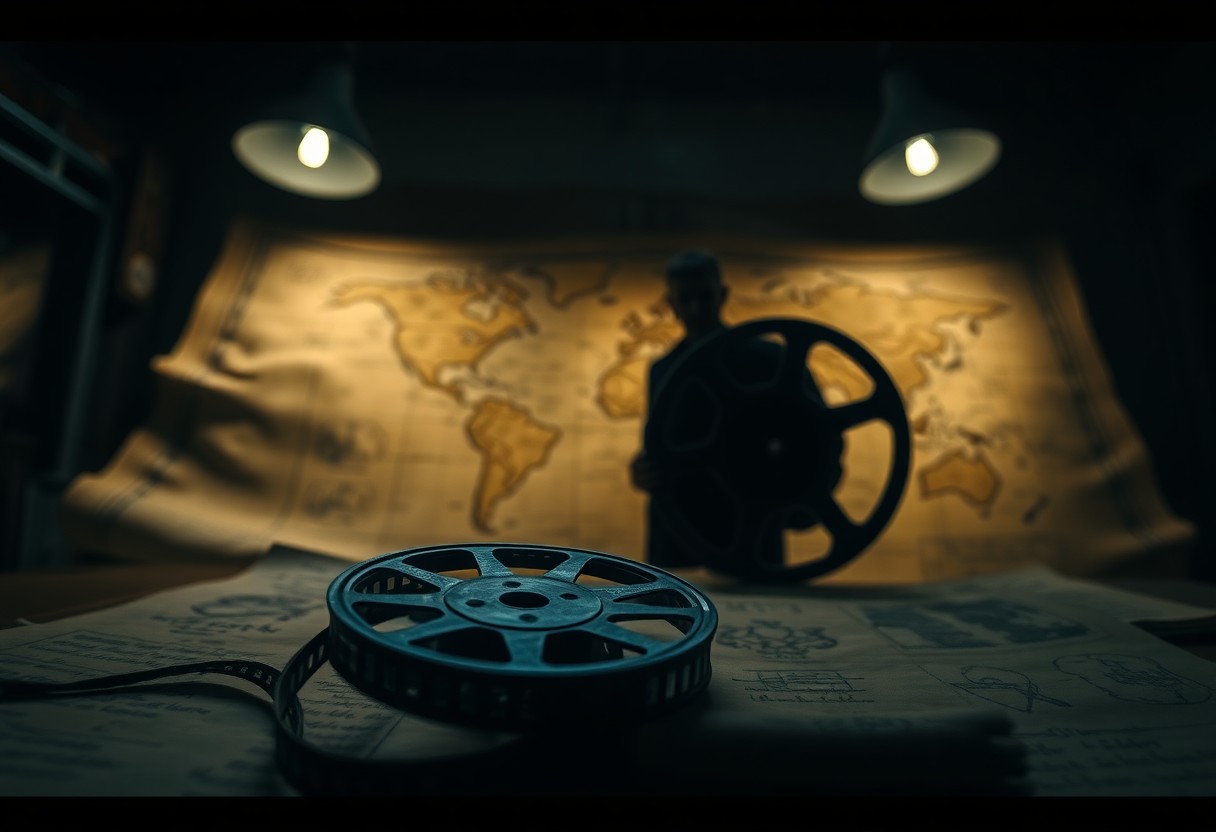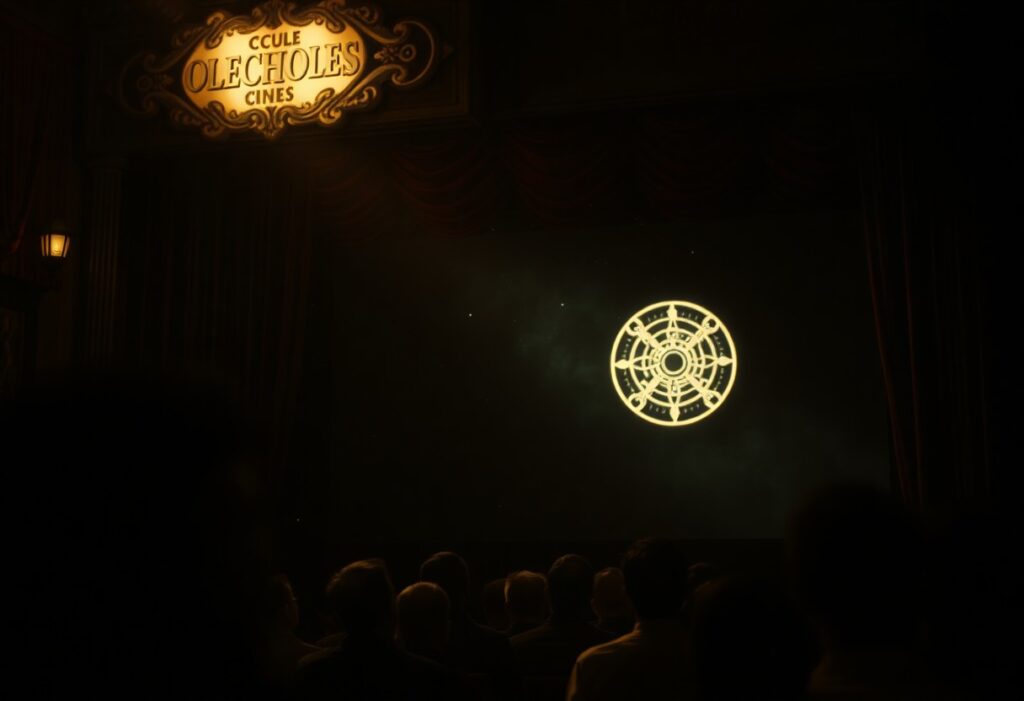It’s all about diving deep into the vibes that flicker on your screen, where hidden truths and dark secrets bubble up from the depths of cinematic frequencies. You might catch whispers of the occult creeping in when you peep those flicks, revealing powerful messages that could shape your perspective. Tap into your intuition and explore those frequencies, ’cause they might just unlock a realm that’s way more than just entertainment.
Key Takeaways:
- Exploration of hidden symbolism in films reflects societal fears and desires.
- Cinematic techniques amplify underlying themes of the occult, enhancing viewer perception.
- Analysis of sound design reveals how auditory elements contribute to the atmosphere of mystery and suspense.

Layers of Meaning: Decoding Symbolism in Film
Films ain’t just about visuals; they’re packed with layers waiting for you to peel back. Every scene got a vibe, and that vibe’s laced with hidden gems of meaning. When you peep the symbols, you start to see how directors weave intricate tales that resonate on deeper frequencies. By tuning in, you can unlock a whole new appreciation for your favorite flicks, seeing them not just as stories, but as reflections of culture, society, and the human experience.
Visual Allegory: Imagery That Speaks Beyond Words
Every frame you see is a canvas splashed with visuals that echo deeper truths. Directors drop visual allegories that turn simple imagery into powerful messages. Like in “The Matrix,” that pill combo ain’t just a choice; it symbolizes awakening to reality. Recognizing these layers helps you vibe with the creator’s vision, letting you reflect on bigger questions while absorbing the brilliance portrayed on-screen.
Hidden Messages: Analyzing Subtext in Popular Movies
Beneath the surface of blockbuster hits lie hidden messages that challenge your perceptions. Films like “Get Out” and “Black Panther” weave social commentary into their plots, pushing you to confront issues like race and identity. You gotta dig deep to catch how these narratives elevate entertainment into a platform for dialogue and awareness.
Take “Get Out”—it’s a horror ride, but it hits you with a sharp social critique on racism disguised as a thriller. When you’re analyzing the subtext, pay attention to the subtle cues—like the way characters interact or the motifs that repeat. Filmmakers drop hints that spark thought, leaving you pondering long after the credits roll. Not just about scares but real life fears wrapped in cinematic flair, guiding you toward a deeper understanding of the world. Get into the film, and uncover truths layered right underneath the surface, just waiting for you to catch ’em.
Frequency and Vibration: The Soundtrack of the Occult
The Power of Sound: How Music Shapes Perception
Sound ain’t just waves in the air; it’s a vibe that hit you right in the soul. Think about them movie scores that trigger your emotions before the action even pops off. Whether it’s a heartbeat thump or eerie whispers in the background, those tracks set the tone, pulling you deeper into the narrative. Music molds your thoughts, shifting your perspective like a shadow in the night. It creates that space where the mundane meets the mystical, connecting you to the unseen frequencies all around.
Sound Frequency and Emotional Resonance: A Deeper Connection
Your feelings ain’t just random; they resonate with the frequencies around you. 432 Hz, for example, connects to the universe’s harmony, boosting your vibe and aligning your spirit. When these vibrations intertwine with visuals on screen, they create a powerful cocktail of emotion that grips your essence. That’s why some flicks stick with you long after the credits roll, tapping into your subconscious and flipping a switch in your mind.
Think about those moments in movies where every note hits hard, echoing like a heartbeat in the silence. Music tuned to specific frequencies can unlock your emotions, stirring feelings of joy, fear, or nostalgia. This connection goes beyond simple enjoyment. Studies show that certain sound frequencies, like 528 Hz, can promote healing and inspire love. Your brain picks up on these vibes, triggering deep emotional responses. That’s why the score of a horror flick can chill your bones, while an epic soundtrack lifts your spirit—altering your mood and perception without you even realizing it.
Cinematic Echoes of Historical Occult Practices
In the world of film, echoes of ancient occult traditions resonate through visuals and narrative choices. Directors tap into these mystical roots, creating a tapestry that challenges your beliefs while gripping your attention. From ancient rituals to modern-day interpretations, flicks like The Witch and Hereditary turn historical practices into chilling experiences, melding fear and fascination.
The Influence of Esotericism: Tracking Roots in Film
Esotericism weaves its way into cinema, influencing themes and characters that reflect hidden knowledge. Think about the mystical symbols in Jacobs Ladder or Inception, where layers of reality and consciousness intertwine. These films invite you to explore the unseen and the unknown, offering a visceral plunge into the arcane.
Provenance and Authenticity: Historical Accuracy vs. Artistic License
Film often dances on the line between reality and interpretation, bending history to fit a narrative. Directors may dilute historical truth for dramatic flair, but in doing so, they can sometimes offer a shadow of the genuine rituals and beliefs. The portrayal of occult practices may not always be spot-on, but the vibe they create resonates.
Exploring the tension between provenance and artistic license reveals how filmmakers navigate accuracy and creative expression. For instance, in Suspiria, the portrayal of witchcraft deviates from historical records yet captures the essence of fear and control present in those practices. This blend can distort your perception of reality, blurring lines between history and sensationalism. While the allure of authenticity keeps you interested, it’s the willingness to embrace a stylized truth that keeps the art thriving and the audiences engaged.
Subconscious Infiltration: Psychological Manipulations in Cinema
Film sneaks into your psyche, planting seeds you don’t even know are there. Those sequences with dark tones and unexpected beats twist your emotional state, making you feel a type of tension that lingers long after the credits roll. Directors leverage sound design and visual cues to play with your feelings, creating a controlled chaos that keeps you hooked. The subconscious gets a workout while you’re entertained, shifting your belief systems without you catching on.
Archetypes and the Collective Unconscious: The Role of Myth
Every story pulls from that well of universal archetypes; they’re familiar, almost in your DNA. Your favorite characters aren’t just random; they’re echoes of mythic figures that resonate with the collective unconscious. Think about heroes, tricksters, and wise old mentors—they tap into deep-rooted emotions that trigger connection, nostalgia, or even conflict.
| Keyword | Details |
| Collective Unconscious | The shared pool of human experiences and symbols. |
| Archetypes | Recurring character types that resonate universally. |
| Myth | Familiar stories that speak to core human experience. |
| Psychological Manipulations | Strategies used to influence audience emotions. |
| Emotional Impact | The lasting effects stories have on your feelings. |
Psychological Tactics: Creating Tension and Fear
Films know how to get under your skin by playing with your emotions. Utilizing jump scares, eerie soundtracks, and tight close-ups, they pull you into a world that feels too real. These tactics turn mundane situations into nightmares, tapping into primal fears that make your heart race. You can’t help but feel the tension building, the dread creeping up—your senses are heightened, and your mind races as the story unfolds.
These psychological tactics aren’t just random tricks; they’re well-researched methods. For example, Psycho‘s infamous shower scene revolutionized horror with its use of editing and sound effects, increasing heart rates in audiences and conditioning them to react with fear. Films mesh surprise and expectation, creating a rollercoaster of emotions that triggers a visceral response. After your heart’s done racing and the credits roll, those feelings linger, having subtly shaped your reality without your permission.
The Audience’s Journey: Engaging with the Occult on Screen
Watching horror is like stepping into a parallel universe where the real world’s worries fade. You become part of a communal experience, feeling the tension rise and your heart race. Each frame pulls you further into a bizarre world where the unknown reigns. Films engage your instincts, inviting you to confront your deepest fears while shivering in your seat, all the while knowing you’re safe. This duality keeps you coming back, spurred by curiosity and adrenaline, drawing out your fantasies and anxieties in a shared ritual of fear and thrill.
The Art of Distrust: What Keeps Us Watching
Distrust in what’s on screen keeps your eyes glued and your thoughts whirring. You’re engaged in a game where plot twists and eerie predictions take center stage, playing with your mind and emotions. The unpredictability fuels your anticipation, prompting you to question every shadow and whisper. As the narrative unfolds, your skepticism deepens, making the ensuing surprises even more impactful. This uncertainty not only hooks you in but creates a connection to the film’s deeper symbols and themes, ensuring you’re in for the long haul.
Catharsis Through Horror: Facing Fears and Transforming Perceptions
Confronting what terrifies you on screen taps into your primal instincts. Horror has the power to transform fears into a cathartic release, allowing you to process emotions that linger in the shadows of your mind. When you watch that monster lurk in the corner, your fears become tangible, but so do the victories over them. You dig deeper, examining what scares you and why, often leading to profound personal insights and a refreshed perspective on your life beyond the screen.
Diving deep into the world of horror, you can uncover personal fears associated with control, loss, or the uncanny. Films like *Hereditary* or *Get Out* transcend mere fright, addressing societal anxieties and the darker side of human nature. This reflection ushers in a transformative experience where you not only wrestle with what haunts you but emerge feeling renewed. Fear becomes a conduit for emotional release, helping to reshape how you perceive not just horror films, but also your own reality. That catharsis? It’s like a therapy session hidden in the shadows.
Conclusion
As a reminder, you gotta tune in to the vibes that flicker in the shadows, where the occult vibes echo through cinematic frequencies, blending the real with the surreal. Keep your eyes peeled for them hidden messages, ’cause they spark that inner truth and unleash those deep thoughts. When you feel the rhythm of the screen, embrace it, let it guide your mind. It’s all about unlocking your perception, diving deep into the layers, and catchin’ the essence of these flicks that reflect your own journey. Stay woke, ’cause the magic’s all around you.
FAQ
Q: What are occult echoes in cinema?
A: Occult echoes in cinema refer to the subconscious themes, symbols, and motifs that evoke esoteric or mystical concepts. These elements often arise from the blending of narrative and visual storytelling, creating layers that resonate with hidden meanings and cultural references rooted in the occult.
Q: How do filmmakers incorporate occult symbolism in their work?
A: Filmmakers often weave occult symbolism into their films through visual imagery, character archetypes, and plot devices. This can include the use of specific colors, geometric shapes, or references to ancient mythologies that align with occult beliefs, enriching the viewer’s experience and inviting deeper interpretation.
Q: What impact do these occult echoes have on audience perception?
A: The presence of occult echoes can profoundly affect audience perception by eliciting emotional responses and encouraging engagement with the narrative on a subconscious level. Viewers may find themselves drawn to the film’s themes, leading to varied interpretations and discussions that extend beyond the surface story.


